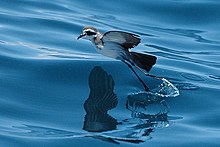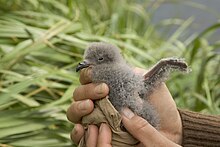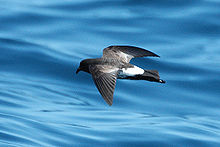Austral storm petrel
| Austral storm petrels | |
|---|---|

| |
| Wilson's storm petrel (Oceanites oceanicus) | |
| Scientific classification | |
| Kingdom: | Animalia |
| Phylum: | Chordata |
| Class: | Aves |
| Order: | Procellariiformes |
| Family: | Oceanitidae Forbes, 1881 |
| Genera | |
Austral storm petrels, or southern storm petrels, are seabirds in the family Oceanitidae, part of the order Procellariiformes. These smallest of seabirds feed on planktonic crustaceans and small fish picked from the surface, typically while hovering. Their flight is fluttering and sometimes bat-like.
Austral storm petrels have a cosmopolitan distribution, being found in all oceans, although only Wilson's storm petrels are found in the Northern Hemisphere. They are almost all strictly pelagic, coming to land only when breeding. In the case of most petrel species, little is known of their behaviour and distribution at sea, where they can be hard to find and harder to identify. They are colonial nesters, displaying strong philopatry to their natal colonies and nesting sites. Most species nest in crevices or burrows, and all but one species attend the breeding colonies nocturnally. Pairs form long-term monogamous bonds and share incubation and chick-feeding duties. Like many species of seabirds, nesting is highly protracted with incubation taking up to 50 days and fledging another 70 days after that.
Several species of austral storm petrel are threatened by human activities. One species, the New Zealand storm petrel, was presumed extinct until rediscovered in 2003. The principal threats to storm petrels are introduced species, particularly mammals, in their breeding colonies; many storm petrels habitually nest on isolated mammal-free islands and are unable to cope with predators such as rats and feral cats.
Taxonomy[]
Two subfamilies of storm petrel were traditionally recognized.[1] The Oceanitinae, or austral storm-petrels, were mostly found in southern waters (though Wilson's storm petrel regularly migrates into the Northern Hemisphere); the seven species are in five genera. The Hydrobatinae, or northern storm petrels, were the two genera Hydrobates and Oceanodroma. They were largely restricted to the Northern Hemisphere, although a few could visit or breed a short distance beyond the Equator.
Cytochrome b DNA sequence analysis suggests that the family was paraphyletic and more accurately treated as distinct families.[2] The same study found that the austral storm petrels are basal within the Procellariiformes. The first split was the subfamily Oceanitidae, with the Hydrobatidae splitting from the rest of the order at a later date. Few fossil species have been found, with the earliest being from the Upper Miocene.[1]
Morphology and flight[]
Austral storm petrels are the smallest of all the seabirds, ranging in size from 15–26 cm in length. Two body shapes occur in the family; the austral storm petrels have short wings, square tails, elongated skulls, and long legs. The legs of all storm petrels are proportionally longer than those of other Procellariiformes, but they are very weak and unable to support the bird's weight for more than a few steps.[1]
The plumage of the Oceanitidae is dark with white underparts (with the exception of Wilson's storm petrel) Onley and Scofield (2007) state that much published information is incorrect, and that photographs in the major seabird books and websites are frequently incorrectly ascribed as to species. They also consider that several national bird lists include species which have been incorrectly identified or have been accepted on inadequate evidence.[3]

Storm petrels use a variety of techniques to aid flight. Most species occasionally feed by surface pattering, holding and moving their feet on the water's surface while holding steady above the water. They remain stationary by hovering with rapid fluttering or using the wind to anchor themselves in place.[4] This method of feeding flight is most commonly used by austral storm petrels. The white-faced storm petrel possesses a unique variation on pattering, holding its wings motionless and at an angle into the wind, it pushes itself off the water's surface in a succession of bounding jumps.[5] Storm petrels also use dynamic soaring and slope soaring to travel over the ocean surface, although this method is used less by this family compared to the northern storm petrels.[6][7] Slope soaring is more straightforward and favoured by the Oceanitidae,[4] the storm petrel turns to the wind, gaining height, from where it can then glide back down to the sea.
Diet[]
The diet of many storm petrels species is poorly known owing to difficulties in researching; overall the family is thought to concentrate on crustaceans.[8] Small fish, oil droplets and molluscs are also taken by many species. Some species are known to be rather more specialised; the grey-backed storm petrel is known to concentrate on the larvae of goose barnacles.
Almost all species forage in the pelagic zone, except for Elliot's storm petrels, which are coastal feeders in the Galapagos Islands. Although storm petrels are capable of swimming well and often form rafts on the water's surface, they do not feed on the water. Instead, feeding usually takes place on the wing, with birds hovering above or "walking" on the surface (see morphology) and snatching small morsels. Rarely, prey is obtained by making shallow dives under the surface.[1]
Like many types of seabirds, storm petrels associate with other species of seabird and marine mammal species to help obtain food. They may benefit from the actions of diving predators such as seals and penguins, which push prey up towards the surface while hunting, allowing the surface-feeding storm petrels to reach them.[9]
Distribution and movements[]
The austral storm petrels typically breed found in the Southern Hemisphere, in contrast to the northern storm-petrel in the Northern Hemisphere.[8]
Several species of storm petrels undertake migrations after the breeding season. The most widely travelled migrant is Wilson's storm petrel, which after breeding in Antarctica and the subantarctic islands, regularly crosses the equator to the waters of the north Pacific and Atlantic Oceans. Some species, such as the grey-backed storm petrel, are thought to be essentially sedentary and do not undertake any migrations away from their breeding islands.
Breeding[]
Storm petrels nest colonially, for the most part on islands, although a few species breed on the mainland, particularly Antarctica. Nesting sites are attended at night to avoid predators.[10] Storm petrels display high levels of philopatry, returning to their natal colonies to breed. In one instance, a band-rumped storm petrel was caught as an adult 2 m from its natal burrow.[11] Storm petrels nest either in burrows dug into soil or sand, or in small crevices in rocks and scree. Competition for nesting sites is intense in colonies where storm petrels compete with other burrowing petrels, with shearwaters having been recorded killing storm petrels to occupy their burrows.[12] Colonies can be extremely large and dense; 840,000 pairs of white-faced storm petrel nest on South East Island in the Chatham Islands in densities between 1.18 and 0.47 burrows/m2.

Storm petrels are monogamous and form long-term pair bonds that last a number of years. As with the other Procellariiformes, a single egg is laid by a pair in a breeding season; if the egg fails, then usually no attempt is made to lay again (although it happens rarely). Both sexes incubate in shifts of up to six days. The egg hatches after 40 or 50 days; the young is brooded continuously for another 7 days or so before being left alone in the nest during the day and fed by regurgitation at night. Meals fed to the chick weigh around 10–20% of the parent's body weight, and consist of both prey items and stomach oil. Stomach oil is an energy-rich (its calorific value is around 9.6 kcal/g) oil created by partly digested prey in a part of the fore gut known as the proventriculus.[13] By partly converting prey items into stomach oil, storm petrels can maximise the amount of energy chicks receive during feed, an advantage for small seabirds that can only make a single visit to the chick during a 24-hour period (at night).[14] The average age at which chicks fledge depends on the species, taking between 50 and 70 days. The time taken to hatch and raise the young is long for the bird's size, but is typical of seabirds, which in general are K-selected, living much longer, delaying breeding for longer, and investing more effort into fewer young.[15] The young leave their burrow at about 62 days. They are independent almost at once and quickly disperse into the ocean. They return to their original colony after 2 or 3 years, but do not breed until at least 4 years old. Storm petrels have been recorded living as long as 30 years.[16]
Threats and conservation[]

Several species of austral storm petrels are threatened by human activities.[17] The New Zealand storm petrel is listed as critically endangered, and was also considered extinct for many years, but was sighted again in 2003, though the population is likely to be very small. Storm petrels face the same threats as other seabirds; in particular, they are threatened by introduced species.
Species[]
| Subfamily | Common name | Scientific name | Status |
|---|---|---|---|
| Oceanitinae | Wilson's storm petrel | Oceanites oceanicus | extant |
| Elliot's storm petrel | Oceanites gracilis | extant | |
| Grey-backed storm petrel | Garrodia nereis | extant | |
| White-faced storm petrel | Pelagodroma marina | extant | |
| Black-bellied storm petrel or Gould's storm petrel | Fregetta tropica | extant | |
| White-bellied storm petrel | Fregetta grallaria | extant | |
| New Zealand storm petrel | Fregetta maoriana | extant | |
| Polynesian storm petrel (including white-throated storm petrel) | Nesofregetta fuliginosa | extant |
References[]
- ^ Jump up to: a b c d Carboneras, C. (1992) "Family Hydrobatidae (Storm petrels)" pp. 258–265 in Handbook of Birds of the World Vol 1. Barcelona:Lynx Edicions, ISBN 84-87334-10-5
- ^ Nunn, G & Stanley, S. (1998). "Body Size Effects and Rates of Cytochrome b Evolution in Tube-Nosed Seabirds". Molecular Biology and Evolution. 15 (10): 1360–1371. doi:10.1093/oxfordjournals.molbev.a025864. PMID 9787440. Corrigendum
- ^ Onley and Scofield, (2007) Albatrosses, Petrels and Shearwaters of the World. Helm, ISBN 978-0-7136-4332-9
- ^ Jump up to: a b Withers, P.C (1979). "Aerodynamics and Hydrodynamics of the 'Hovering' Flight of Wilson's Storm Petrel". Journal of Experimental Biology. 80: 83–91.
- ^ Erickson, J. (1955). "Flight behavior of the Procellariiformes" (PDF). The Auk. 72 (4): 415–420. doi:10.2307/4081455.
- ^ Pennycuick, C. J. (1982). "The flight of petrels and albatrosses (Procellariiformes), observed in South Georgia and its vicinity". Philosophical Transactions of the Royal Society of London B. 300 (1098): 75–106. doi:10.1098/rstb.1982.0158.
- ^ Brinkley, E. & Humann, A. (2001) "Storm petrels" in The Sibley Guide to Bird Life and Behaviour (Elphick, C., Dunning J. & Sibley D. eds) Alfred A. Knopf:New York ISBN 0-679-45123-4
- ^ Jump up to: a b Brooke, M. (2004). Albatrosses and Petrels Across the World Oxford University Press, Oxford, UK ISBN 0-19-850125-0
- ^ Harrison N.; Whitehouse M.; Heinemann D.; Prince P.; Hunt G.; Veit R. (1991). "Observations of Multispecies Seabird Flocks around South Georgia" (PDF). Auk. 108 (4): 801–810.
- ^ Bretagnolle, V. (1990). "Effect of moon on activity of petrels (Class Aves) from the Selvagen Islands (Portugal)". Canadian Journal of Zoology. 68 (7): 1404–1409. doi:10.1139/z90-209.
- ^ Harris, M. (1979). "Survival and ages of first breeding of Galapagos seabirds" (PDF). Bird Banding. 50 (1): 56–61. doi:10.2307/4512409.
- ^ Ramos, J.A.; Monteiro, L.R.; Sola, E.; Moniz, Z. (1997). "Characteristics and competition of nest cavities in burrowing Procellariiformes" (PDF). Condor. 99 (3): 634–641. doi:10.2307/1370475.
- ^ Warham, J. (1976). "The Incidence, Function and ecological significance of petrel stomach oils" (PDF). Proceedings of the New Zealand Ecological Society. 24: 84–93. Archived from the original (PDF) on 2006-07-24.
- ^ Obst, B & Nagy, K (1993). "Stomach Oil and the Energy Budget of Wilson's Storm Petrel Nestlings" (PDF). Condor. 95 (4): 792–805. doi:10.2307/1369418.
- ^ Schreiber, Elizabeth A. & Burger, Joanne.(2001.) Biology of Marine Birds, Boca Raton:CRC Press, ISBN 0-8493-9882-7
- ^ Klimkiewicz, M. K. 2007. Longevity Records of North American Birds Archived 2011-05-19 at the Wayback Machine. Version 2007.1. Patuxent Wildlife Research Center. Bird Banding Laboratory. Laurel MD.
- ^ IUCN, 2006. Red List: Storm petrel Species Retrieved August 27, 2006.
External links[]
| Wikimedia Commons has media related to Oceanitidae. |
| Wikispecies has information related to Hydrobatidae. |
- Storm petrel videos on the Internet Bird Collection
- Oceanitidae
- Seabirds